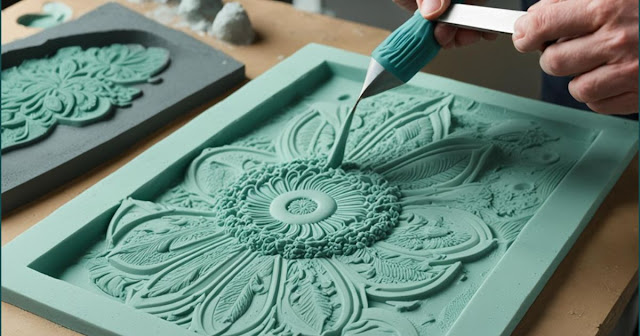Have you ever admired a beautifully crafted sculpture or a perfectly detailed architectural element and wondered how to create something similar? The art of mold making opens up a world of creative possibilities, allowing you to replicate intricate designs and bring your artistic visions to life. Whether you're an aspiring artist, craftsperson, or DIY enthusiast, this comprehensive guide will walk you through everything you need to know about how to make a mold and create stunning pieces that showcase your creativity.
Understanding the Art of Mold Making: A Foundation for Success
Before diving into specific techniques, it's crucial to understand what makes mold art unique and powerful as a creative medium. Mold making is more than just creating copies – it's about preserving details, understanding materials, and mastering techniques that have been refined over centuries of artistic practice.
The Science Behind Successful Molds
The key to creating perfect molds lies in understanding the chemical and physical properties of your materials:
· Curing processes and temperature effects
· Material shrinkage rates
· Chemical compatibility between mold and casting materials
· Surface tension and detail reproduction
Essential Materials and Tools for Your Mold Making Journey
Basic Materials
Silicone Rubber
· Room temperature vulcanizing (RTV) silicone
· Tin-cure vs. platinum-cure options
· Food-grade alternatives for culinary projects
Release Agents
· Petroleum-based releases
· Wax-based options
· Natural alternatives
Support Materials
· Plaster bandages
· Rigid mother molds
· Registration keys
Required Tools
· Mixing containers (both disposable and reusable)
· Measuring scales and cups
· Sculpting tools
· Release agent applicators
· Safety equipment
· Clean-up supplies
Advanced Mold Making Techniques
1. Block Molds: Creating Complex Forms
Block molds represent the pinnacle of mold making precision, perfect for:
· Intricate figurines
· Complex jewelry designs
· Detailed architectural elements
· Custom prototype parts
Key Steps for Block Mold Creation
· Prepare your master model
· Calculate parting lines
· Build containment walls
· Pour silicone in stages
· Create registration keys
· Add vents and sprues
2. Brush-On Mold Techniques
Ideal for large or vertical surfaces, brush-on molds offer unique advantages:
· Reduced material usage
· Better control over thickness
· Ability to work with vertical surfaces
· Perfect for textured originals
3. Vacuum Degassing Methods
For professional-quality results:
· Removes air bubbles
· Improves detail reproduction
· Extends mold life
· Ensures consistent results
· Creative Applications and Project Ideas
Architectural Elements
· Custom crown molding
· Decorative ceiling medallions
· Period-specific restoration pieces
· Custom trim and accent pieces
Fine Art Projects
Sculpture Reproduction
· Limited edition pieces
· Gallery-quality replicas
· Custom bases and stands
Relief Panels
· Decorative wall art
· Custom signage
· Memorial plaques
Mixed Media Integration
· Combining cast elements with other materials
· Creating unique assemblages
· Innovative installation pieces
Practical Applications
Home Decor
· Custom cabinet hardware
· Unique picture frames
· Decorative wall elements
· Personalized house numbers
Garden Art
· Weather-resistant sculptures
· Custom stepping stones
· Decorative fence posts
· Water feature elements
Professional Tips for Outstanding Results
Material Selection
· Choose materials based on your specific project requirements
· Consider durability needs
· Factor in cost efficiency for multiple castings
· Account for environmental conditions
Workflow Optimization
Preparation
· Organize your workspace
· Gather all materials before starting
· Create a timeline for multi-step projects
· Document your process
Execution
· Monitor temperature and humidity
· Follow exact mixing ratios
· Use proper safety equipment
· Maintain clean working conditions
Troubleshooting Common Issues
· Addressing air bubbles
· Fixing tears and rips
· Dealing with incomplete curing
· Preventing shrinkage problems
Advanced Casting Techniques
Working with Different Materials
Resin Casting
· Polyurethane resins
· Epoxy systems
· UV-curable options
Concrete and Cement
· Mix designs
· Reinforcement options
· Surface treatments
Metal Casting
· Lost wax process
· Metal-filled resins
· Cold casting techniques
Environmental Considerations and Sustainability
Eco-Friendly Options
· Water-based release agents
· Biodegradable materials
· Recycling and reuse strategies
· Minimal waste techniques
Conclusion
Ready to embark on your mold making journey? ArtMolds is your premier destination for all your mold making needs. With our extensive selection of professional-grade materials, expert guidance, and commitment to quality, we're here to help you create extraordinary pieces that stand the test of time. Visit www.artmolds.comtoday and discover why artists and creators trust us for their most important projects. Bring your creative vision to life – your masterpiece is waiting!



